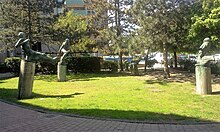Stadium at the Gesundbrunnen
| Stadium at the Gesundbrunnen | |
|---|---|

|
|
| View of the stadium (in the background, 1974) | |
| Data | |
| place |
|
| Coordinates | 52 ° 32 '59.9 " N , 13 ° 23' 36" E |
| opening | February 9, 1924 |
| First game | Hertha BSC - VfB Pankow |
| demolition | 1974 |
| surface | race |
| capacity | 35,239 |
| Societies) | |
The stadium at Gesundbrunnen (also known as Plumpe in Berlin vernacular or simply as Hertha-Platz ) was a sports facility in the Gesundbrunnen district of Berlin . It was built between 1923 and 1924 and served as the home ground of the Hertha BSC football club for almost four decades . After Hertha had to sell the site due to financial difficulties, the stadium was demolished in 1974.
Location and capacity
The stadium was located in the center of Gesundbrunnen directly on the Swinemünde Bridge in the eastern part of what was then the Wedding district . It was bounded in the north by Behmstrasse , in the west by Bellermannstrasse and in the east and south by the railway tracks of the nearby Gesundbrunnen station . The sports facility initially offered space for 35,239 spectators, who were divided into 2,642 seats and 32,597 standing places. Due to the damage caused by the Second World War , the capacity was later reduced to around 20,000 spectators.
The term "clumsy"
In the Berlin vernacular , the stadium was and is predominantly referred to as "plump". This term is originally a Berlin variant for water pumps that can be found on many streets in the city. There was also a water pump in Behmstrasse that was connected to a healing spring in the nearby Luisenbad . The name of the district as Gesundbrunnen is derived from the healing spring . From the pump, in turn, initially "plump" emerged as a nickname for the district. Since the stadium at Gesundbrunnen was therefore “due to the plump”, the name was later shortened to “plump”.
The healing spring, first mentioned in 1748, was filled in at the beginning of the 20th century during sewer works and supposedly rediscovered in the basement of a residential building near Gesundbrunnen train station in summer 2008. However, after a detailed investigation, this “find” only turned out to be rising groundwater , a typical Berlin problem.
history
On June 1, 1923, the members of the recently created Hertha BSC (a merger of the BFC Hertha 1892 and the Berliner Sport-Club ) founded the Sportplatz Bau- und Betriebs- GmbH , which on the day it was founded the site of the former Schebera ice rink acquired. The ice rink was opposite the old Schebera sports field , which Hertha had used (with interruptions) since 1904. The name "Schebera" goes back to the innkeeper Joseph Schebera, who built the sports field in 1900 and later leased it to Hertha.
The move had become necessary because the BFC Hertha could no longer raise the lease for Schebera-Platz and wanted to become independent of the Berliner SC together with the financially powerful merger partner. At the end of 1923, the expansion of the square began. First, a covered wooden grandstand was built for 3600 spectators. Later on, the stands behind the gate were built, which the fans called "Uhrenberg" (because of the stadium clock attached here) and "Zauberberg". The stadium was opened on February 9, 1924 with the game Hertha BSC against VfB Pankow , which ended with a 1-0 victory for the hosts. After the completion of all construction work, the arena finally held 35,239 spectators and was, among other things, the venue for the group games of the 1936 Olympic football tournament .
After the Second World War, the stadium showed severe damage. The large grandstand burned down completely on the night of May 5th to 6th, 1945. Hertha was only able to move into the Plumpe again in December 1950 . After the renovation , the arena still held 20,000 spectators. For the establishment of the Bundesliga in the 1963/64 season, Hertha BSC moved to the Berlin Olympic Stadium , because the plump did not meet the minimum requirements for Bundesliga games. In the regional league seasons from 1965 to 1968, Hertha returned to their old stadium before they left the stadium for good. After the Bundesliga scandal in 1971, Hertha, whose players were also involved, threatened financial failure. The club had to sell the plump and the venue was demolished in 1974 to make way for 440 new apartments. The last game was scheduled for October 22, 1974 against 1. FC Nürnberg , but had to be canceled due to heavy rain.
In this residential complex, four football player sculptures by Michael Schoenholtz are reminiscent of the former stadium.
literature
- Werner Skrentny (Hrsg.): The big book of the German football stadiums . Göttingen 2001, ISBN 3-89533-306-9 , pp. 53-55.
- Michael Jahn: Hertha's old living room . In: Berliner Zeitung , August 6, 2013
Web links
- History hertha-geschichte.de
Individual evidence
- ↑ clumsy. (swf; 38 kB) Heartfields - Football Wear, accessed on January 22, 2009 .
- ↑ Uta Keseling: Our P (l) umpe . In: Berliner Morgenpost , October 21, 2007
- ↑ Hertha BSC Berlin - passion for football with obstacles in the German capital. Berlin-Magazin.info, accessed on January 22, 2009 .
- ↑ "Heilquelle" is only Panke water. In: morgenpost.de. August 22, 2008. Retrieved September 23, 2008 .
- ↑ Uwe Aulich: The supposed healing spring is groundwater . In: Berliner Zeitung , August 21, 2008
- ^ Clemens Niedenthal: added time . In: Berliner Zeitung , April 12, 2006
- ↑ a b A LOOK INTO THE ARCHIVE: STADIUM CONSTRUCTION. herthabsc.de, accessed on October 24, 2017 .



